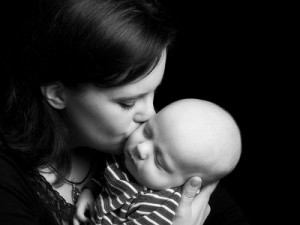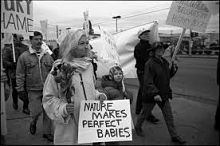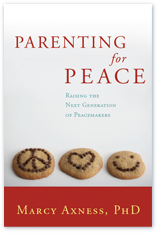Parenting for Peace
 Make no mistake: mothers can change the world. And now is the time for us to realize it. Through recognizing our true nature and innate power, together with the shaping impact of how we bring children to life and to maturity, we can wield timely and imperative healing change.
Make no mistake: mothers can change the world. And now is the time for us to realize it. Through recognizing our true nature and innate power, together with the shaping impact of how we bring children to life and to maturity, we can wield timely and imperative healing change.
The Dalai Lama said at the Vancouver Peace Summit that the world will be saved be the western woman. In the midst of our global human, economic and environmental crises, we have been overlooking a powerful — perhaps the most powerful — means of changing the world toward more peace and prosperity: the consciousness with which we bring our children to life and shepherd them into adulthood. If we really want to change the world, we need to raise a generation “built for peace” from their earliest beginnings — with the brain circuitry for such essential peacemaker capacities as empathy, trust, self-regulation and imagination.
We stand at an unprecedented moment in human history: thanks to our brilliant technology (if we don’t get too mesmerized and distracted by it!), it is the first time large swaths of the human family have the time with which to reflect on our inner lives, to come to really know who and how we are, and how we can become our very best — and then to offer our best to our children. Developmental neuroscience indeed reveals that our own self-knowledge and growth is a most powerful lever for our children’s wellbeing and success.
Deciding What We Want
If you look at fundamental shifts or trends within societies, they have all happened through the force of individual citizens changing their minds about what they want. As visionary pollster Mark Penn points out in his book Microtrends (and backs up with many examples), “In today’s mass societies, it takes only one percent of people making a dedicated choice—contrary to the mainstream’s choice—to create a movement that can change the world.”[i]
 Look at the rise in popularity of alternative medical modalities such as acupuncture. This didn’t happen because expert panels announced research on its effectiveness; this happened because average, everyday people increasingly sought it out and discovered on their own that it worked, which created consumer demand and drove further research. Now acupuncture is far more accepted than it was even ten years ago, much more available, and covered by many insurance companies.
Look at the rise in popularity of alternative medical modalities such as acupuncture. This didn’t happen because expert panels announced research on its effectiveness; this happened because average, everyday people increasingly sought it out and discovered on their own that it worked, which created consumer demand and drove further research. Now acupuncture is far more accepted than it was even ten years ago, much more available, and covered by many insurance companies.
I propose the same can happen with the values around how we perceive ourselves and how we bring children to life and to maturity. Now, the idea that parents wield the most fundamental, lasting influence on the socioemotional health of their children is not very politically correct. The notion that there is an ideal toward which we might strive in any human endeavor is also un-PC, for it runs the risk of making people feel guilty. But our politically correct, responsibility-free mentality creates disempowerment and hopelessness instead! Parenting for Peace is about hope and empowerment.
As author Dotty Coplen suggests, “The more we understand about the future consequences of what we are doing, and the intent that goes with the action, the more successful we will be in caring for our children with our own purposes and goals of parenting in mind. Parents need to decide together what they believe to be a healthy human being.”[ii]
The “Generation Peace” Profile
Our world has evolved radically, and so must our understanding of psychosocial health. Today we know through scientific research that a socially healthy human being has a brain wired with the capacity for self-regulation, self-reflection, trust, and empathy. And, the peace I refer to is not simply the absence of violence or strife, and neither is it the stereotypical soft-focused dream scene of doves and olive branches. This peace is a state of being vibrantly at-ease, from cell to soul, steeped in the tranquil conviction I’m a worthy participant in life… fit to meet any challenge. Vitally engaged in both inner and outer life, imbued with comprehensive social intelligence, minimal psychological or physiological defense patterns, with an array of readily deployable capacities for manifesting the inner experience of joy in the outer world.
These key qualities include intellectual and emotional flexibility, robust imagination and the ability to devise innovative solutions to complex puzzles. Also very important, the quality of resilience: how does the person handle daily stresses? A child who learns to readily regain internal balance after a frustrating moment becomes an adult capable of embracing peace instead of conflict. All of these capacities rely on well-developed brain centers that govern self-regulation, sensory integration and social intelligence. Someone with a well-wired brain doesn’t get overwhelmed with stress hormones, at least not for very long. They bounce back.
Peace also suggests a condition of feeling safe. Of being sane and centered. It presumes a fundamental posture of security, wellbeing, and an orientation toward growth, exploration and connectedness, with self and with others. We know from the new field of interpersonal neurobiology that this experience of safety, of peace at the level of biochemistry, is something that can become woven into the very fabric of our neurophysiology.
This is the purpose of the seven steps and principles that Parenting for Peace is based upon: they foster the optimal development of those brain centers and support the flourishing of the whole child — body and mind. It is less about doing than it is about not doing — not getting in the way of Nature’s elegant blueprint for socially adept, relationally astute humans.
This is not about us making children our projects; our children want to be received, seen, and enjoyed for who they are in the moment. But they also count on us to help them fully blossom! And since they primarily learn from who we are, our project becomes ourselves. But here’s the amazing paradox: you can teach your child only based on what you are — and there’s an aspect of your child that will be more than you. The fact is, Nature not only allows us but dearly asks of us to have children much better than who we are!
How, Then, Shall We Parent?
At this point in human history, I guess I would dare to ask, “Why be a parent if not to try to bring a peacemaker on earth?” It might be peace through embroidery or engineering or being a CEO. Ultimately, our consciously enacted wish for our children becomes that they unfold as individuals with the heart to embrace and exemplify peacefulness, the psyche to experience joy and intimacy, the mind to innovate solutions to social and ecological challenges, and the will to enact such innovations. Such a human is never a genetically predetermined given, but the result of dynamic interactions between genetics and environment — with parents being the most influential environmental variable.
[i] Penn, Mark, and E. Kinney Zalesne. Microtrends: The Small Forces Behind Tomorrow’s Big Changes. New York: Twelve, 2009.
[ii] Coplen, Dotty. Parenting for a Healthy Future. Gloucestershire, UK: Hawthorn House, 1995.
Mother and baby image by Lisa Pflaum
Tags: brain development, imagination, intellegence, interpersonal neurobiology, parenting for peace, peace, self-regulation


